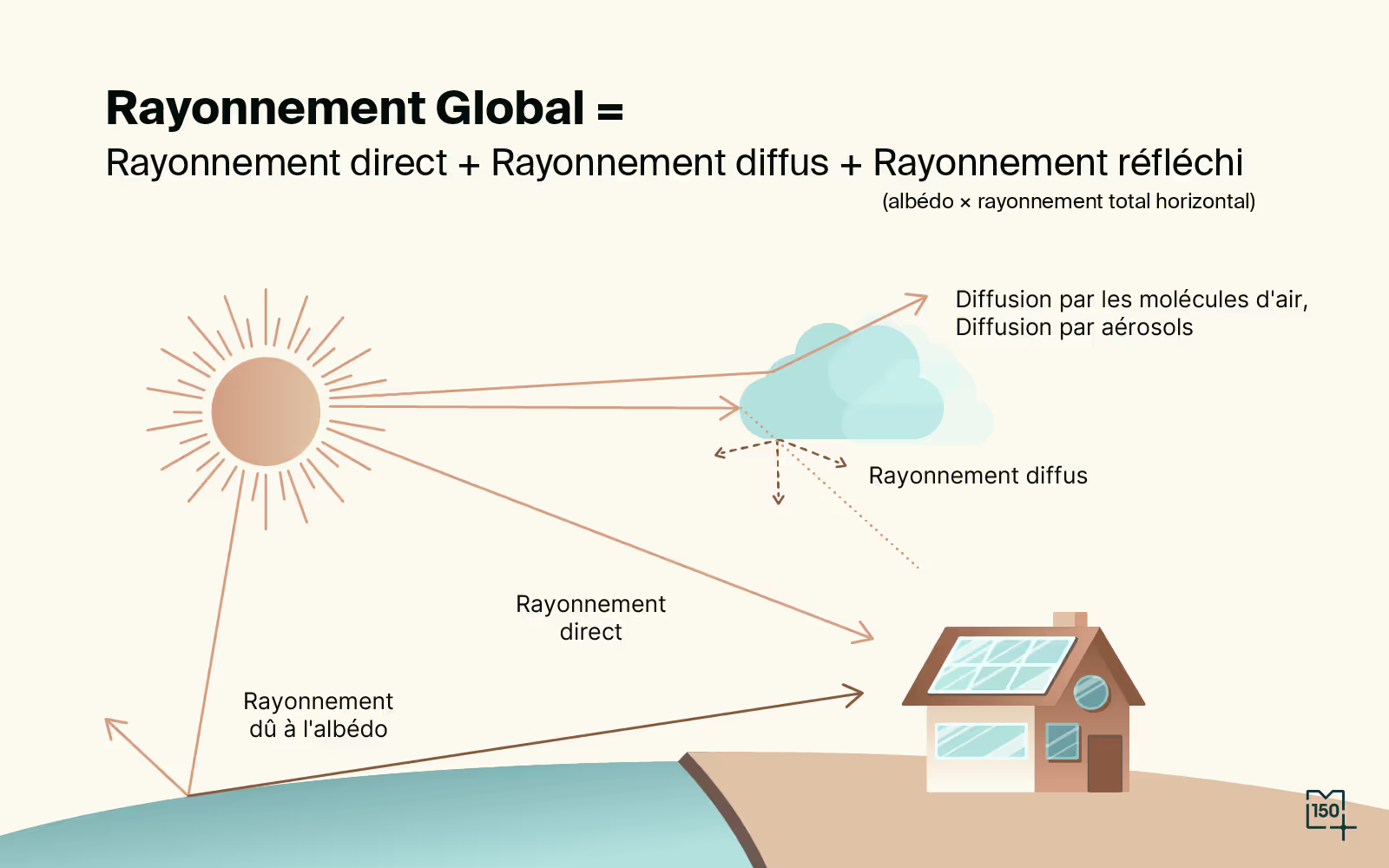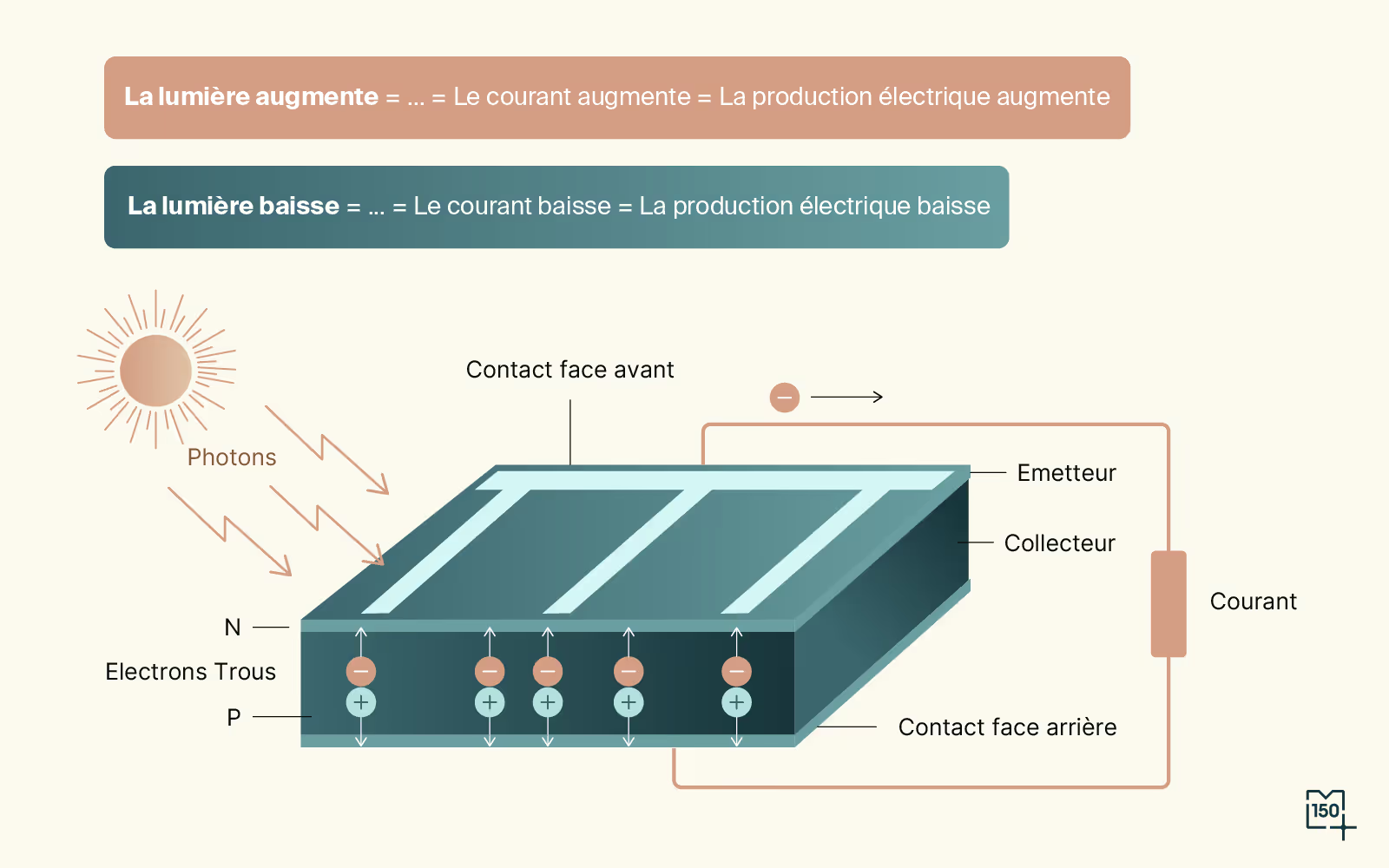Comment fonctionne un panneau photovoltaïque ?

Heading 1
Heading 2
Heading 3
Heading 4
Heading 5
Heading 6
Lorem ipsum dolor sit amet, consectetur adipiscing elit, sed do eiusmod tempor incididunt ut labore et dolore magna aliqua. Ut enim ad minim veniam, quis nostrud exercitation ullamco laboris nisi ut aliquip ex ea commodo consequat. Duis aute irure dolor in reprehenderit in voluptate velit esse cillum dolore eu fugiat nulla pariatur.
Block quote
Ordered list
- Item 1
- Item 2
- Item 3
Unordered list
- Item A
- Item B
- Item C
Bold text
Emphasis
Superscript
Subscript
L'énergie solaire représente une solution incontournable pour un avenir durable. Mais quel est exactement le fonctionnement d’un panneau photovoltaïque ? La France est en pleine ascension sur le front de l'énergie solaire, avec une production impressionnante de 13,6 TWh en 2020 et une augmentation de 11,1% par rapport à l'année précédente. Pour maximiser l'indépendance énergétique, les panneaux photovoltaïques, combinés avec des technologies nouvelles sur le marché, comme les batteries virtuelles, jouent un rôle clé dans la gestion durable de l'énergie, rendant chaque installation plus autonome et efficace. Explorer le potentiel de cette énergie et comprendre son fonctionnement est désormais essentiel.
Dans cet article, on vous explique concrètement comment fonctionne un panneau photovoltaïque !
Définition et Fonctionnement d’un panneau photovoltaïque
Définition, Composants et fonctionnement d’une Cellule Photovoltaïque
Un panneau solaire photovoltaïque est un assemblage de cellules photovoltaïques encapsulées entre des couches protectrices de verre, comme nos modules biverre bifaciaux, les plus résistants du marché. Au cœur de chaque cellule se trouve le silicium, un matériau semi-conducteur issu du sable qui excelle dans la conversion de la lumière solaire en électricité. Cette caractéristique est cruciale pour le fonctionnement d’une cellule photovoltaïque. Le silicium permet non seulement une capture efficace de l'énergie solaire mais assure aussi que cette énergie est convertie en une forme d'électricité propre et renouvelable, alimentant tout, des habitations aux industries.


Les Différents Types de Panneaux Solaires
Les panneaux solaires se déclinent en plusieurs types, chacun adapté à des besoins spécifiques :
Bi-verre : En utilisant du verre des deux côtés, ces panneaux offrent une meilleure protection et une durée de vie prolongée, tout en maintenant une efficacité énergétique optimale même sous des conditions climatiques extrêmes.
Bi-facial : Grâce à leur capacité à capturer la lumière des deux côtés, ces panneaux produisent une quantité d'énergie supérieure, surtout dans des environnements où la lumière est réfléchie par des surfaces comme la neige.
Black Crystal full black : Avec leur esthétique totalement noire, ces panneaux ne sont pas seulement élégants ; ils absorbent également un maximum de lumière solaire, ce qui optimise leur performance.
Hétérojonction : La technologie d'hétérojonction combine le silicium cristallin et amorphe pour capturer plus de lumière, ce qui permet d'améliorer la performance même par temps couvert.
Chez mylight150, nous proposons chacune de ces solutions. N’attendez plus pour découvrir nos produits !

Comment fonctionne un Panneau Solaire ?
La Conversion de l'Énergie Solaire en Électricité
Le fonctionnement d’un panneau photovoltaïque implique la capture de photons par les cellules solaires, ce qui excite les électrons et génère un flux électrique. Ce processus, découvert par Edmond Becquerel en 1839, est connu sous le nom d'effet photovoltaïque. Ce phénomène fondamental permet aux panneaux solaires de convertir efficacement l'énergie solaire en électricité.


Le Cycle de Production d'Électricité
Après la génération de courant continu (DC) par les panneaux, celui-ci est converti en courant alternatif (AC) utilisable par les ménages et les entreprises grâce à un onduleur. Ce composant est vital dans le fonctionnement du panneau solaire car il permet l'intégration de l'énergie solaire dans le réseau électrique.
Installation et Maintenance des Panneaux Solaires Photovoltaïques
Étapes de l'Installation
L'installation de panneaux solaires nécessite l'expertise de professionnels pour garantir un fonctionnement optimal de vos panneaux solaires. Elle commence par une évaluation minutieuse du site, où des experts déterminent l'orientation optimale et l'angle des panneaux pour capter le maximum de lumière solaire. Cette phase est suivie de l'installation de supports robustes et de la fixation sécurisée des panneaux, que ce soit sur des toitures ou sur des structures au sol. Vous avez un projet en tête ? Faites-votre simulation gratuitement !
Entretien et Durée de Vie
Bien que les panneaux solaires nécessitent peu d'entretien, un nettoyage régulier est essentiel pour préserver leur efficacité maximale. La durée de vie de ces panneaux peut s'étendre jusqu'à 30 ans, mais leur performance peut légèrement diminuer avec le temps. Ainsi, pour assurer une meilleure rentabilité de l'installation, mylight150 propose une technologie de panneau qui s'inscrit dans le temps et des garanties produits et performance qui s’étendent sur 30 ans.
Avantages et limites du Fonctionnement des Panneaux Solaires Photovoltaïques
Quels sont les avantages du solaire ?
Les panneaux solaires photovoltaïques offrent plusieurs avantages significatifs :
1- Énergie renouvelable et propre : Ils transforment la lumière du soleil, une ressource abondante et gratuite, en électricité, contribuant ainsi à réduire les émissions de gaz à effet de serre.
2- Réduction des factures d'électricité : Une fois installés, les panneaux solaires peuvent considérablement diminuer les coûts énergétiques.
3- Indépendance énergétique : Les panneaux solaires permettent aux utilisateurs de produire leur propre énergie - notamment avec une batterie virtuelle - réduisant la dépendance aux fournisseurs traditionnels et aux fluctuations des prix de l'énergie.
Les Limites et les idées reçues sur les panneaux solaires
Cependant, les panneaux solaires présentent également certaines limites :
1- Coût initial relativement élevé : L'investissement initial pour l'achat et l'installation peut être substantiel, bien que cela puisse être largement atténué par diverses aides et crédits d'impôt. L'ajout d'une batterie virtuelle permet également d'améliorer l'amortissement de l'investissement et de réduire les factures d'électricité, rendant le système plus rentable à long terme.
2- Dépendance aux conditions météorologiques : La production des panneaux solaires est directement affectée par les conditions météorologiques (forte chaleur ou temps gris). Cependant, des solutions de stockage d'énergie peuvent aider à réguler l'approvisionnement et de nouvelles technologies de panneaux, comme l’hétérojonction, permettent une meilleure production d'énergie même lorsqu'il fait chaud ou encore par temps couvert.
3- Nécessité d'un espace adéquat pour l'installation : Une surface suffisante et bien orientée est essentielle pour maximiser l'efficacité des panneaux solaires. Toutefois, dans les zones urbaines denses ou sur les bâtiments avec des toits de petite taille ou inadaptés, l'espace disponible pour l'installation est naturellement limité. Cela souligne l'importance de choisir les meilleurs panneaux du marché, capables de maximiser la production d'énergie par tout temps, pour optimiser l'utilisation de chaque mètre carré disponible.
Vers un Avenir Solaire
Les panneaux photovoltaïques sont essentiels pour la transition énergétique. Leur capacité à convertir la lumière solaire en électricité contribue significativement à la réduction des émissions de gaz à effet de serre. Les avancées technologiques, comme les cellules à hétérojonction et la technologie bi-verre, maximisent la capture de l'énergie solaire, prolongent la durée de vie des installations et réduisent les coûts de production et d'installation.
L'énergie photovoltaïque joue un rôle crucial dans la lutte contre le changement climatique, soutenant les communautés locales et créant des emplois dans les énergies renouvelables. Cette technologie contribue non seulement à l'économie et à la protection environnementale, mais elle est aussi reconnue pour sa durabilité et son potentiel de recyclage, aidant à atteindre l'objectif de zéro émission nette de CO2 d'ici 2050.
En bref, investir dans l'énergie solaire est un choix stratégique pour un avenir autonome. Ce type d’installation pourrait vous séduire ? Vous avez encore des questions sur le fonctionnement des panneaux solaires photovoltaïques ? N’hésitez pas à simuler votre projet !
Estimez vos économies avec notre simulateur


Simulez vos futures économies dès maintenant


.jpg)
-p-1080.avif)